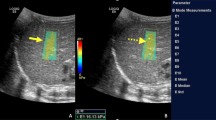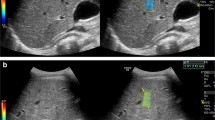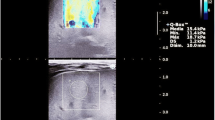Abstract
Background
Ultrasound shear wave elastography (SWE) measures liver stiffness noninvasively, but few studies have defined cutoff values for detecting liver fibrosis in pediatric patients using 2-D ultrasound SWE.
Objective
To evaluate the diagnostic performance of 2-D ultrasound SWE and define cutoff values for liver fibrosis in pediatric patients, using Canon (Toshiba) Aplio ultrasound systems.
Materials and methods
This was an institutional review board-approved retrospective study of patients (≤18 years old) who had undergone both liver 2-D ultrasound SWE and percutaneous liver biopsy within 6 months. Liver biopsies were staged using the METAVIR (fibrosis) scoring system. Continuous data were compared using the Mann-Whitney U test. Receiver operating characteristic (ROC) curve analysis was used to evaluate diagnostic performance.
Results
Forty-six patients, with a median age of 11.5 years (interquartile range: 8.0–14.3 years), were included. Twenty-three patients were male (50%). Twenty-seven patients had a METAVIR fibrosis score of F0–1, and 19 patients had a score of F2–4. For differentiating METAVIR F0–1 from F2-–4, the area under the ROC (AuROC) was 0.75 (95% confidence interval [CI]: 0.60–0.90). A cutoff of >1.89 m/s yielded sensitivity of 73.7% (95% CI: 51.2–88.2) and specificity of 77.8% (95% CI: 59.2–89.4). For the subset of patients without histological hepatic steatosis (n=35), the AuROC was 0.86 (95% CI: 0.71–1.0). The same cutoff of >1.89 m/s yielded a sensitivity of 80.0% (95% CI: 54.8–93.0) and specificity of 95.0% (95% CI 76.4–99.7).
Conclusion
Two-dimensional ultrasound SWE distinguishes patients with no/mild fibrosis from those with moderate/severe fibrosis with good sensitivity and specificity. Diagnostic performance is comparable to that published for magnetic resonance elastography and is likely adversely impacted by steatosis.


Similar content being viewed by others
References
Barr RG, Ferraioli G, Palmeri ML et al (2015) Elastography assessment of liver fibrosis: Society of Radiologists in ultrasound consensus conference statement. Radiology 276:845–861
Dillman JR, Heider A, Bilhartz JL et al (2015) Ultrasound shear wave speed measurements correlate with liver fibrosis in children. Pediatr Radiol 45:1480–1488
Farmakis SG, Buchanan PM, Guzman MA et al (2019) Shear wave elastography correlates with liver fibrosis scores in pediatric patients with liver disease. Pediatr Radiol 49:1742–1753
Dietrich CF, Sirli R, Ferraioli G et al (2018) Current knowledge in ultrasound-based liver elastography of pediatric patients. Appl Sci 8:944
Dietrich CF, Bamber J, Berzigotti A et al (2017) EFSUMB guidelines and recommendations on the clinical use of liver ultrasound elastography, update 2017 (long version). Ultraschall Med 38:e16–e47
Ferraioli G, Wong VW, Castera L et al (2018) Liver ultrasound elastography: an update to the World Federation for Ultrasound in medicine and biology guidelines and recommendations. Ultrasound Med Biol 44:2419–2440
Hall TJ, Milkowski A, Garra B et al (2013) RSNA/QIBA: Shear wave speed as a biomarker for liver fibrosis staging. 2013 IEEE International Ultrasonics Symposium (IUS), pp 397-400
Palmeri M, Nightingale K, Fielding S et al (2015) RSNA QIBA ultrasound shear wave speed phase II phantom study in viscoelastic media. 2015 IEEE International Ultrasonics Symposium (IUS), pp 1-4
Piscaglia F, Salvatore V, Mulazzani L et al (2017) Differences in liver stiffness values obtained with new ultrasound elastography machines and Fibroscan: a comparative study. Dig Liver Dis 49:802–808
Ferraioli G, De Silvestri A, Lissandrin R et al (2019) Evaluation of inter-system variability in liver stiffness measurements. Ultraschall Med 40:64–75
Kim JR, Suh CH, Yoon HM et al (2018) The diagnostic performance of shear-wave elastography for liver fibrosis in children and adolescents: a systematic review and diagnostic meta-analysis. Eur Radiol 28:1175–1186
Ozkan MB, Bilgici MC, Eren E et al (2017) Role of point shear wave elastography in the determination of the severity of fibrosis in ediatric liver diseases with pathologic correlations. J Ultrasound Med 36:2337–2344
Marginean CO, Marginean C (2012) Elastographic assessment of liver fibrosis in children: a prospective single center experience. Eur J Radiol 81:e870–e874
Lawrence AE, Dienhart M, Cooper JN et al (2019) Ultrasound elastography as a non-invasive method to monitor liver disease in children with short bowel syndrome: updated results. J Pediatr Surg 54:1179–1183
Phelps A, Ramachandran R, Courtier J et al (2017) Ultrasound elastography: is there a shear wave speed cutoff for pediatric liver fibrosis and inflammation? Clin Imaging 41:95–100
Tomita H, Hoshino K, Fuchimoto Y et al (2013) Acoustic radiation force impulse imaging for assessing graft fibrosis after pediatric living donor liver transplantation: a pilot study. Liver Transpl 19:1202–1213
Tutar O, Beser OF, Adaletli I et al (2014) Shear wave elastography in the evaluation of liver fibrosis in children. J Pediatr Gastroenterol Nutr 58:750–755
Dhyani M, Gee MS, Misdraji J et al (2015) Feasibility study for assessing liver fibrosis in paediatric and adolescent patients using real-time shear wave elastography. J Med Imaging Radiat Oncol 59:687–694
Chen S, Liao B, Zhong Z et al (2016) Supersonic shearwave elastography in the assessment of liver fibrosis for postoperative patients with biliary atresia. Sci Rep 6:31057
Franchi-Abella S, Corno L, Gonzales E et al (2016) Feasibility and diagnostic accuracy of supersonic shear-wave elastography for the assessment of liver stiffness and liver fibrosis in children: a pilot study of 96 patients. Radiology 278:554–562
Garcovich M, Veraldi S, Di Stasio E et al (2017) Liver stiffness in pediatric patients with fatty liver disease: diagnostic accuracy and reproducibility of shear-wave elastography. Radiology 283:820–827
Schwimmer JB, Behling C, Angeles JE et al (2017) Magnetic resonance elastography measured shear stiffness as a biomarker of fibrosis in pediatric nonalcoholic fatty liver disease. Hepatology 66:1474–1485
Trout AT, Sheridan RM, Serai SD et al (2018) Diagnostic performance of MR elastography for liver fibrosis in children and young adults with a spectrum of liver diseases. Radiology 287:824–832
Goodman ZD (2007) Grading and staging systems for inflammation and fibrosis in chronic liver diseases. J Hepatol 47:598–607
Joshi M, Dillman JR, Singh K et al (2018) Quantitative MRI of fatty liver disease in a large pediatric cohort: correlation between liver fat fraction, stiffness, volume, and patient-specific factors. Abdom Radiol (NY) 43:1168–1179
Evans JD (1996) Straightforward statistics for the behavioral sciences. Brooks/Cole Publishing Company, Pacific Grove
Trout AT, Xanthakos SA, Bennett PS, Dillman JR (2020) Liver shear wave speed and other quantitative ultrasound measures of liver parenchyma: prospective evaluation in healthy children and adults. AJR Am J Roentgenol 214:557–565
Chung M, Baird GL, Weiss KE, Beland MD (2019) 2D shear wave elastography: measurement acquisition and reliability criteria in noninvasive assessment of liver fibrosis. Abdom Radiol (NY) 44:3285–3294
Coco B, Oliveri F, Maina A et al (2007) Transient elastography: a new surrogate marker of liver fibrosis influenced by major changes of transaminases. J Viral Hepat 14:360–369
Yen YH, Chang KC, Tsai MC et al (2018) Elevated body mass index is a risk factor associated with possible liver cirrhosis across different etiologies of chronic liver disease. J Formos Med Assoc 117:268–275
Galina P, Alexopoulou E, Zellos A et al (2019) Performance of two--dimensional ultrasound shear wave elastography: reference values of normal liver stiffness in children. Pediatr Radiol 49:91–98
Author information
Authors and Affiliations
Corresponding author
Ethics declarations
Conflicts of interest
Dr. Trout receives grant funding for a shear wave elastography study separate from the current study from Canon Medical Systems. Dr. Dillman receives grant funding for shear wave elastography studies separate from the current study from Canon Medical Systems and Siemens Healthineers.
Additional information
Publisher’s note
Springer Nature remains neutral with regard to jurisdictional claims in published maps and institutional affiliations.
Rights and permissions
About this article
Cite this article
Alhashmi, G.H., Gupta, A., Trout, A.T. et al. Two-dimensional ultrasound shear wave elastography for identifying and staging liver fibrosis in pediatric patients with known or suspected liver disease: a clinical effectiveness study. Pediatr Radiol 50, 1255–1262 (2020). https://doi.org/10.1007/s00247-020-04720-2
Received:
Revised:
Accepted:
Published:
Issue Date:
DOI: https://doi.org/10.1007/s00247-020-04720-2




